| |
|
|
| |
Artillery
of the Schutztruppe and Overseas Forces
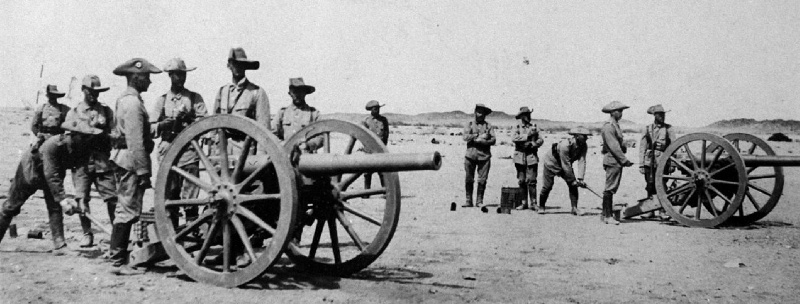
7.7cm Feldkanone
C96aA
Guns of the Halbbatterie Westerfeld, South West African Schutztruppe
1914
Photo from Tsumeb Museum /
WikiCommons
From the mid nineteenth century to
the First World War the technology of artillery advanced
greatly. In just over 60 years, muzzle loading cannon were
replaced by rapid firing, rifled, breech loading guns capable of firing
many more, much larger shells over great distances with ever increasing
accuracy. The biggest change during the period of the German
colonies was the addition of recoil systems to guns. This made
the gun more stable in its position after firing and meant crews
no longer had to haul the gun back into position and re-adjust
the aim before the next shot. The overall effect was to vastly
increase the number of accurate rounds a gun could fire in a
given time.
The Schutztruppe and overseas German
forces used artillery from both ends of the technological scale.
On the one hand the Schutztruppe in Africa often used
obsolete weapons without recoil systems, while on the other hand new experimental
weapons such as the Erhardt 1908 Mountain Gun with its
revolutionary recoil system were only used in
Africa. The German naval base at Tsingtao had massive modern gun
emplacements while the Germans in East Africa sometimes made do
with improvised or captured guns. The modern naval guns of the
SMS Königsberg were mounted on gun carriages for use
as the largest land artillery in East Africa for a time in the
First World War.
By 1914, the Schutztruppe in South West
Africa, East Africa and to a lesser extent, Cameroon all had
regular artillery batteries or field guns attached to infantry
companies. The smaller colonies of Togo, New Guinea and Samoa
did not have effective artillery. Marine Infantry and Imperial Army units posted overseas (such as
those in China for the Boxer Rebellion and Palestine in the
First World War) had their own artillery batteries. Some actions in the
colonies and overseas were also supported by guns from naval
ships (see Naval History Page).
Special Thanks on this page to
the researches of Mark E Horan, Charles Rollins Ware, Holger
Kotthaus, Oliver Eicke and MC Henuis, mostly made
public on the
Axis
History Forum and
Panzer
Forum. |
|
| |
|
|
|
|
|
Types of Artillery commonly in use
Overseas and in the
Colonies
I. Field Artillery |
| |
|
|
|
|
| |
Feldkanone
C73 |
|
|
|
| |
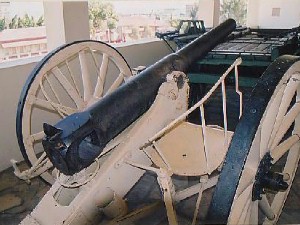
Leichte Feldkanone C73
formerly of the South West African Schutztruppe now
on display at the
Alte Fest in Windhoek, Namibia
Photo ©
Phil Buhler |
|
The Krupp
Feldkanone
C73 (Construktionsjahr
1873), was a breech loading
field gun without a recoil system. It was introduced to
Prussian army in 1873 in response to the lessons learned in the
Franco-Prussian War, where the French artillery had proven
supiurior to that of
the Prussians.
The C73 came in two calibres, 7.85cm
L/20 C73 Leichte Feldkanone and the 8.8cm L/22.6 C73 Schwere Feldkanone
(L stands for Lange,
length of the barrel measured in multiples of its calibre).
These guns were issued to the
Schutztruppe of South West Africa, East Africa and
Cameroon in the 1890s when they were still reasonably current.
Two were later sent to New Guinea. Many of the guns in Africa
were still in active service in 1914 although by European
standards they were quite obsolete. |
|
| |
|
|
|
|
| |
Feldkanone
C96 |
|
|
|
| |
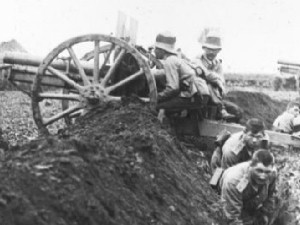
Feldkanone C96nA
of the Marine Feld Batterie
of the III. Seebataillon, Tsingtao. Note the recoil system under the
barrel
Photo from Bundesarchiv /
WikiCommons |
|
The Krupp 7.7cm Feldkanone
C96 was
introduced to the Prussian army in 1896 but was soon
outclassed by the French Canon de 75 Modèle 1897 which
was the first artillery gun to feature a hydro-pneumatic recoil
system. Stocks
of the C96 in Germany were upgraded as the C96nA with a similar
system fitted under the barrel from 1904 onwards but not those in the colonies.
In 1914 the Schutztruppe
of South West Africa still had 22 of the old C96aA guns in active service.
By then they also had eight of the new C96nA guns in active
service.
The field artillery
batteries of the East Asian Expeditionary Corps were
also most likely equipped with the C96aA. Marine Feld Batterie
of the III. Seebataillon, Tsingtao. may initially have been equipped
with the old C96aA but by 1914 they had the recoiling
C96nA.
|
|
| |
|
|
|
|
|
II. Specialist Artillery |
| |
Mountain Guns |
|
|
|
| |
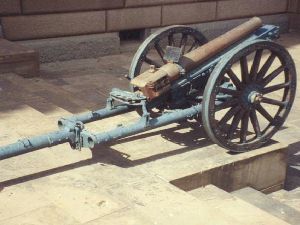
7.5cm
Gebirgskanone M08
formerly of the South West African Schutztruppe now on
display at the Union Buildings, Pretoria, South Africa
Photo © MC Heunis |
|
Mountain guns were useful in the
colonies and over rough terrain as they could be broken down
into parts and carried by pack animals. They also usually
featured higher angles of elevation than field artillery.
Several types of mountain gun were used in the colonies. The
fixed recoil
7,2 cm Gebirgskanone L/14 M98 was used in
South West Africa and judging from period photographs also by
the Mountain batteries of the East Asian Expeditionary Corps.
In East Africa there were two 6 cm
Krupp Kolonial und Bergkanone M70 and a
further three 6cm Gebirgshaubitze in Cameroon.
In 1904 Ehrhardt designed a new
75mm mountain gun using the
world's first
variable recoil system. Variable recoil is still a feature of modern
artillery pieces. Only fifteen
of the 7,5cm
Gebirgskanone L/17 M08
were ever made and the gun was never used by the German army
in Europe.
Twelve of them were issued to the Schutztruppe of
South West Africa in 1908.
Two 7.5cm guns were brought to the
Schutztruppe in German East Africa in 1916 on board the blockade
runner SS Marie. These were 7,5cm Krupp Gebirgskanone L/14
M12. |
|
| |
|
|
|
|
| |
Howitzers |
|
|
|
| |
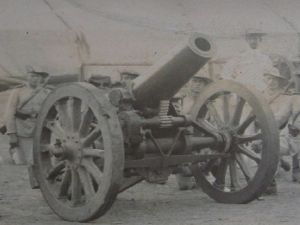
15 cm schweres
Feldhaubitze M93
of the East Asian Expeditionary Corps, 1900
Photo ©
Peter Klein |
|
The Krupp 15cm schweres
Feldhaubitze M93 was the first mobile heavy howitzer
used by the Prussian army and saw action in the Boxer
Rebellion used by the Heavy Field Howitzer Batteries of
the East Asian Expeditionary Corps.
The
10,5cm Feldhaubitze M98
field howitzer was a later a
fixed recoil weapon made by Rheinmetall and
introduced to the Prussian army in 1898. Four of these howitzers were sent to South West Africa to
serve with the expanded Schutztruppe during the Herero
Rebellion and remained there since. The Light Field
Howitzer
Batteries of the East Asian Expeditionary Corps sent to
China in 1900 were also equipped with the 10.5 cm Feldhaubitze M98.
The last of these returned to Germany in 1902.
In 1904 a new recoil system
was designed by Krupp and from 1909 was fitted to most existing guns in
Germany, as the 10.5cm Feldhaubitze
M98/09. Four 10.5cm Field Howitzers
FH98/09 were brought
to East Africa by the blockade running ship SS Marie in 1916.
|
|
| |
|
|
|
|
| |
Light Guns |
|
|
|
| |
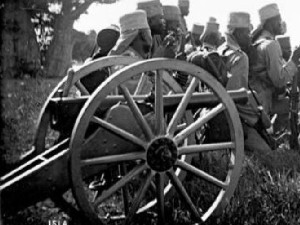
3.7cm
Schnell-Ladekanone M93
of the East African Schutztruppe
Photo by Walther
Dobbertin Bundesarchiv /
WikiCommons |
|
Heavy artillery was not what was needed in some colonies such as East Africa
and Cameroon where transportation was a problem and the tribal
enemy did not usually built stone fortifications.
In these colonies the
Schutztruppe's needs for a light highly mobile infantry gun were
met by the
3.7cm Krupp-Gruson Schnell-Ladekanone L/30 M1893. The
Schutztruppe of East Africa and Cameroon had three such weapons
each distributed among their Field Companies. |
|
|
III. Naval Guns |
| |
Land Batteries |
|
|
|
| |
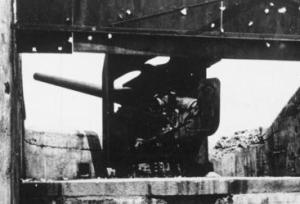
10.5cm Schnellladekanone
from the Tsingtao Naval Batteries after its
destruction
Photo from
Bundesarchiv /
WikiCommons |
|
Germany
built up land based naval artillery batteries to defend its home
ports, likewise land based naval artillery batteries were
installed at Tsingtao, the German naval base in China. By 1914
the batteries at Tsingtao consisted of dozens of guns ranging in
calibre up to a massive 28cm.
There were no other land based
naval artillery batteries in the colonies before the outbreak of
the First World War. However during the war, after the Scuttling
of the SMS Königsberg her 10.5cm guns were installed as land
based batteries guarding their coasts at Dar Es Salaam, Tanga
and the Great Lakes.
|
|
| |
Ships Guns |
|
|
|
| |
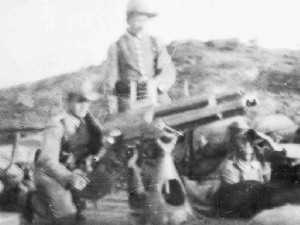
3.7cm Gruson-Hotchkiss Revolverkanone
on its original fixed pivot
stand used by the Schutztruppe during the Herero Rebellion.
Photo ©
Frankfurt University Koloniales Bildarchiv |
|
As well as Imperial Navy ships
shelling rebellious locals in the colonies, they also sometimes
sent their deck mounted guns for use on land in times of emergency.
In 1904 the SMS Habicht sent her
3.7cm Gruson-Hotchkiss Revolverkanonen
on land to assist against the Herero Rebellion. The same type of
revolver canon was deployed by the SMS Planet in New Guinea and the SMS
Möwe also deployed the same
gun on land in German East Africa in 1914.
During the Siege of Tsingtao
the SMS Jaguar and the Austro-Hungarian SMS Kaiserin Elizabeth were
scuttled and their artillery used on land. Perhaps most famously two 8.8cm and ten 10.5cm guns from the SMS
Königsberg were deployed on land in East Africa during the First
World War. |
|
| |
Landing Guns |
|
|
|
| |
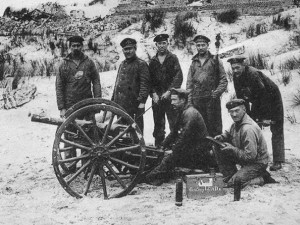
6cm Bootslandungskanone
used by the Kaiserliches Marinekorps in Flanders c1916
Photo © Eddy Lambrecht
Kaiserliches Marinekorps Flandern |
|
Some
ships carried guns with wheeled carriages intended to accompany
landing parties ashore. The SMS Königsberg sent its
6cm Bootslandungskanone
ashore to serve with the Schutztruppe in German East Africa
in August 1914. Another two similar guns arrived in East Africa
on board the blockade runner, SS Rubens/Kronborg in 1916. |
|
| |
|
|
|
|
|
IV. Other Guns |
| |
Obsolete Weapons |
|
|
|
| |
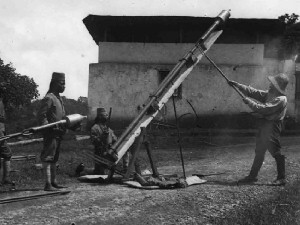
Out-dated Congreve style Rocket
used by the East African Schutztruppe c1914
Photo ©
Frankfurt University Koloniales Bildarchiv |
|
Various
curious guns were used in the colonies for various reasons from
fake decoy guns to the old saluting gun at Apia harbour in
German Samoa. But it was in East Africa during the First World
War that the most variety of out-dated, improvised captured different German guns and
calibres were put into use. |
|
| |
Decoy Guns
|
|
|
|
| |
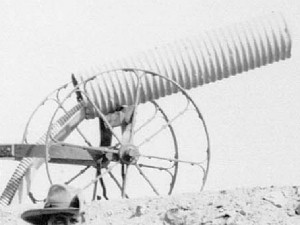
Decoy Gun
used by the SWAfrican Schutztruppe c1914
Photo ©
Frankfurt University Koloniales Bildarchiv |
|
The Germans used dummy or
decoy guns in several colonies during the First World
War in attempts to make various defensive points look
stronger than were they were to to draw enemy fire away
from genuine emplacements.
The photograph on the
left was taken
in South West Africa during the First World War. It shows
what appears to be a very unconvincing decoy gun but it may well have been enough to
fool observers from a distance or an
aeroplane.
Recommended Internal Link -
Decoy Guns |
|
| |
|
|
|
|
| |
|
|
|
|
| |
|
|
|
|
| |
South West
Africa
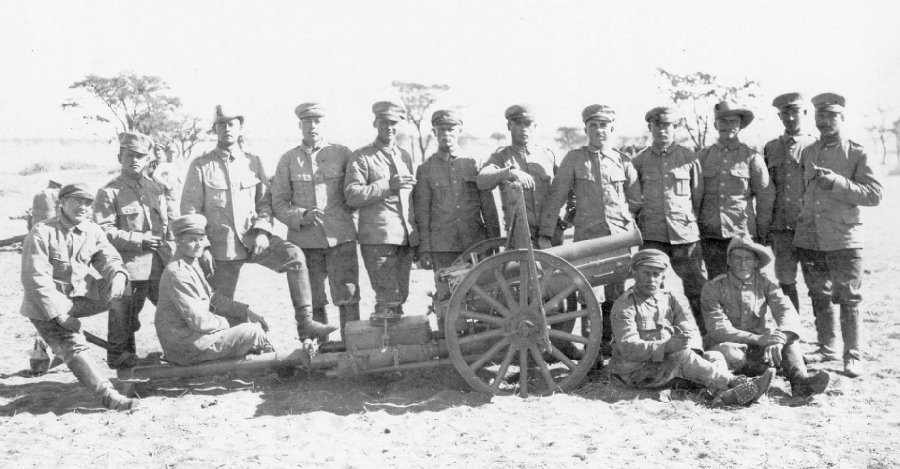
Schutztruppe
7.5cm
Gebirgskanone L/17 M08
Mountain Gun and Crew 1914
Photo ©
Frankfurt University Koloniales Bildarchiv |
|
| |
|
|
|
|
| |
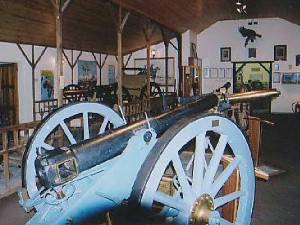
7.85cm C73 Light Field Gun
on display at the
Tsumeb Museum,
Namibia.
Photo ©
Phil Buhler
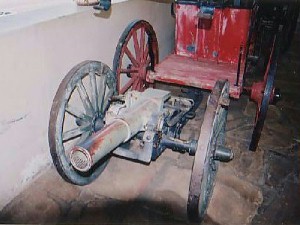
7.2 cm Gebirgskanone L/14 M98
on display at the Alte Fest, Windhoek, Namibia
Photo ©
Phil Buhler

Maschinenkanone M97
formerly of the Marine Expeditionskorps
on display at the Tsumeb Museum, Namibia
Photo © MC Heunis
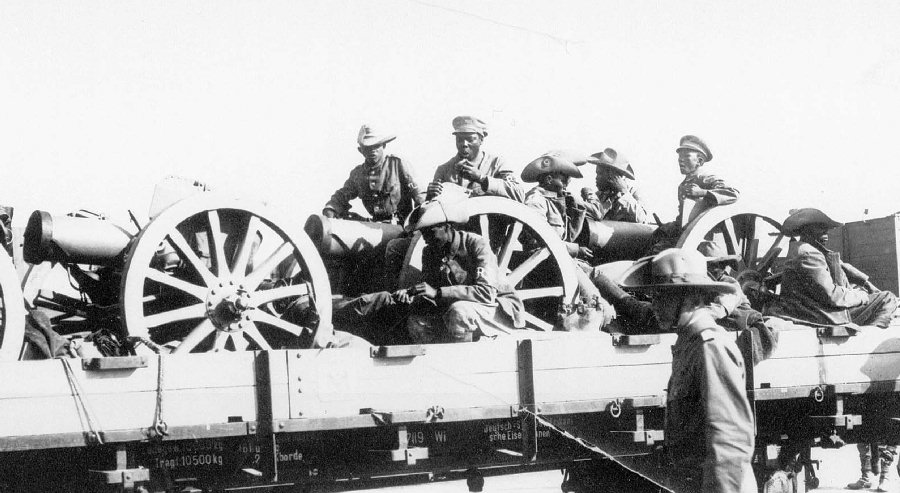
10.5cm M98 Field Howitzers
Three of the four howitzers belonging to the
Schutztruppe 2. Reservebatterie ("Ochsenbatterie"-
as they were drawn by oxen)
entrained for the front with
their African drivers in 1914-15.
Photo ©
Frankfurt University Koloniales Bildarchiv
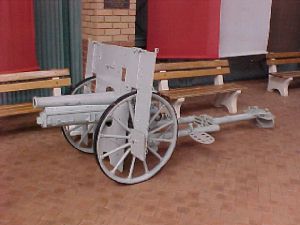
7.5cm
Gebirgskanone M08
on display at the South African Museum of
Military History
Photo © MC Heunis
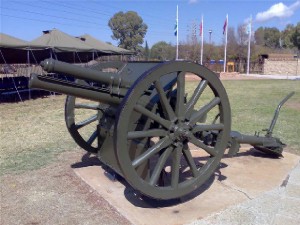
Captured South African 13 Pounder Gun
Displayed at the
Gunners Memorial in Potchefstroom, South
Africa.
Photo © Dominic Hoole |
|
A field
artillery battery was added to the Schutztruppe in 1896,
although some artillery pieces may have operated before then.
More artillery was added during the Herero Rebellion until at the height of the
rebellion the Schutztruppe had eight field artillery batteries
and one mountain artillery battery. Most of this
artillery had remained in South West Africa after
the rebellion although sources disagree as to how
much of it was still serviceable when the First
World War broke out ten years later. Before the
Schutztruppe surrendered to South African forces in 1915 they dumped
much of their artillery into
Lake Otjikoto to
prevent it falling into enemy hands. Many of those guns have since been
recovered and restored while others are still in the lake.
Schutztruppe Guns before the
Herero Rebellion
5x 7.85 cm Feldkanone
C73
Five Krupp Light
Field Guns were issued to the South West African
Schutztruppe between 1894-96 and later served in the Herero
Rebellion. By 1914 they were no longer in active service
with the Schutztruppe. Four of these outdated guns were
then pressed into service.
4x 5.7cm Schnellfeurgeschüzten
Four 5.7cm Quick Firing
Guns were delivered to the Schutztruppe in 1894 and were
in service throughout the rebellions in South West
Africa. By 1914 they were longer in active service and only three
could be put into working order.
4x
7.2 cm Gebirgskanone L/14 M98
These mountain guns wee issued to the Schutztruppe
between 1897-1903. Sources quote different numbers of
guns in use between three and six although four seems a
popular choice (for example in Schneider). It may be
that six were supplied but only four were serviceable in
1914. They supplied
the Mountain artillery battery of the Schutztruppe
before until
being replaced by the 1908 7.5cm Mountain Gun.
Reinforcements during and
after the Herero Rebellion
3x
3.7cm Revolverkanone
These three naval
Revolver Cannons were brought to South West Africa
by SMS Habicht when the Herero Rebellion broke out
in 1904. They were the first new guns to arrive in
the colony in response to the rebellion. Some sources disagree
and claim there were only two. These guns were no
longer in regular Schutztruppe use by 1914 but were pressed
back into service.
8x
3.7cm Maschinenkanone M97
These eight Krupp machine
cannons were brought to South West Africa in 1904 by the
Marine Expeditionskorps to fight the Herero rebels and
remained there ever since. These guns were no longer in
regular Schutztruppe use by 1914 but were pressed back into
service.
22x 7.7cm
Feldkanone C96aA
Twenty-two of these guns were sent to South West Africa during
the Herero Rebellion despite them being obsolete by European
standards. In 1914 the Schutztruppe
still had all 22 of the old C96aA guns in active service.
8x 7.7cm
Feldkanone C96nA
The C96nA was an
upgraded version of the C96aA with a new recoil system
introduced from 1904. Eight of these guns were sent to South West
Africa during the Herero Rebellion. In 1914 the Schutztruppe
still had all eight in active service.
At the outbreak of the
First World War there were 16,000 7.7cm rounds between the
30 C96 guns in the colony.
4x
10.5 cm Feldhaubitze M98
The
1898 Field Howitzer was a
fixed recoil weapon made by Rheinmetall and
introduced to the Prussian army in 1898. In 1904 a new
recoil system was designed by Krupp and fitted to most
existing guns in Germany. Meanwhile four of the old
version howitzers were sent to South West Africa to
serve with the expanded Schutztruppe during the Herero
Rebellion and remained there since. In 1914 they had a stock of 2,000
shells.
2x Feldkanone 91/93
"Die Kaiserliche Schutz- und
Polizeitruppe für Afrika" by Reinhard Schneider reports that two FK 91/93 guns were borrowed from
the Cameroon Schutztruppe at the outbreak of the Herero Rebellion in 1904. I have not
found later references to these guns in either South West
African or Cameroon sources to know if they remained in service in
South West Africa or were returned to Cameroon after the rebellion.
12x 7.5cm
Gebirgskanone L/17 M08
In 1904 Ehrhardt designed a new
mountain gun using the
world's first
variable recoil system. Twelve of them were issued to the Schutztruppe of
South West Africa in 1908. In 1914 they had a stock of
6,000 shells.
All twelve guns were surrendered at Khorab in 1915 and still survive in
different locations, mostly in South Africa.
Recommended Internal
Links - Schutztruppe
Mountain Guns
Guns in Active
Schutztruppe Service in 1914
Of the guns mentioned
above, the following were still in active Schutztruppe
service at the out break of the First World War (other older
guns were also pressed back into use as described above).
22x 7.7cm
Feldkanone C96aA
8x 7.7cm
Feldkanone C96nA
12x 7.5cm
Gebirgskanone L/17 M08
Captured Guns
in the First World War
2x South African 13 Pounder Guns
Two
British made 13 Pounder (7.64
cm)
Light Field Guns (numbers 288 and 289) were captured from South
African forces by the Schutztruppe at the Battle of Sandfontein on 23rd
September 1914. Neither of the guns were
later used in action against
their former owners. They were dumped in Lake
Otjikoto in 1915, along with other Schutztruppe
guns but both have since been recovered.
Gun number 288 is now on display at the
Tsumeb
Museum, Namibia.
Gun number 289 is on display at the
Gunners Memorial in Potchefstroom, South
Africa.
Recommended Internal
Links -
Schutztruppe
Mountain Guns
Guns
from Lake
Otjikoto Page
|
|
| |
|
|
|
|
| |
|
|
|
|
| |
|
|
|
|
| |
German East Africa
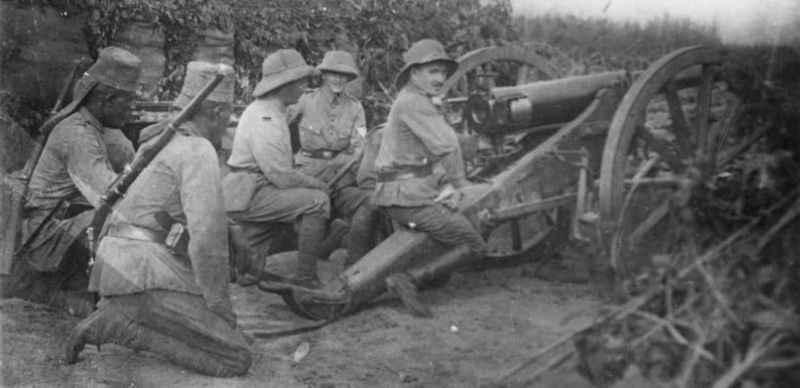
7.85cm Leichte Feldkanone
C73 in Action during the First World War
Photo
Bundesarchiv /
WikiCommons
|
|
| |
|
|
|
|
| |
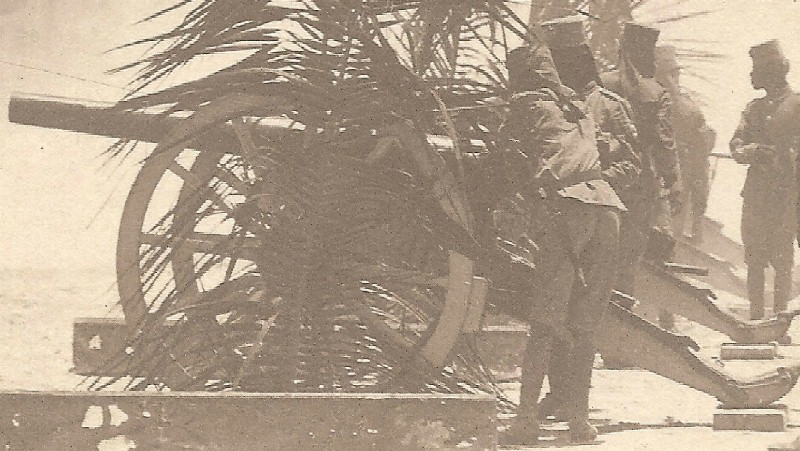
8.8cm Schwere Feldkanone
C73
See
East African
Polizeitruppe Artillery for the full version of this
photograph
Photo
©
Karsten Herzogenrath

6cm
Krupp Kolonial und Bergkanone M1870
Photo from Krupp catalogue courtesy of Holger
Kotthaus
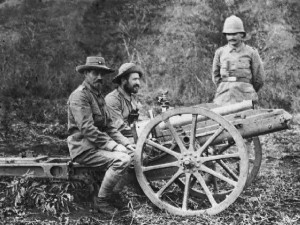
7.5cm Gebirgskanone
M08 from SS Marie
Photo ©
Frankfurt University Koloniales Bildarchiv
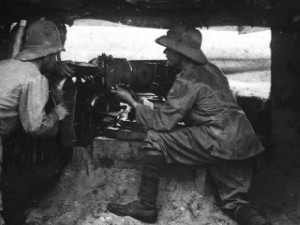
Captured British 4.7cm
Hotchkiss gun
used by the Schutztruppe's Abteilung Delta.
Photo ©
Frankfurt University Koloniales Bildarchiv
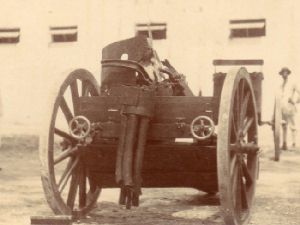
3.7 cm Revolverkanone
from the SMS Möwe, mounted on a C73 gun carriage
after receiving a direct hit from the Royal Navy's HMS Vengeance,
Bagamoyo 1916
Photo © William Thomas Clegg /
Bob William Green
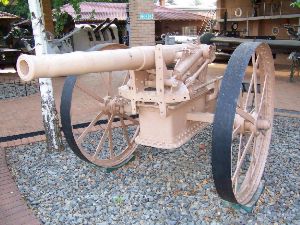
8.8cm SMS Königsberg Gun
Displayed at the
Museum of Military History, Johannesburg, South Africa.
Photo © MC Heunis |
|
The first artillery pieces in German East Africa
were eighteen C73
Field Guns issued to the Wissmanntruppe on 3 May 1889. By 1914 the Schutztruppe had
a total of 35 guns (of which they were able to field 31) organised
as an artillery detachment based in the capital Dar-Es-Salaam with
various guns distributed among the different Feldkompagnien.
Artillery of the Wissmanntruppe 1889
Sixteen field guns were issued to the Wissmanntruppe to serve in the Abushiri Rebellion. These
guns remained the backbone of the Schutztruppe artillery up
until the First World War.
4x 8.8cm Schwere Feldkanone
C73
Four of these
heavy field guns were issued to the Wissmanntruppe in May 1889. Though outdated by European
standards, they served the Schutztruppe throughout its
history and three were still in service by 1914.
12x 7.85cm Leichte Feldkanone
C73
Twelve of these
light field guns
were issued to the Wissmanntruppe in 1889. They served
the Schutztruppe throughout its history and nine were
left in service by 1914.
Artillery
of the Schutztruppe in 1914
As well as the remaining three light
and nine heavy C73 field guns still in service with the
Schutztruppe at the outbreak of the First World War, they
also had the following guns in service.
3x
3.7cm Krupp-Gruson Schnell-Ladekanone L/30 M1893
There was a large stock of 1,189 shells available for these guns
in 1914.
2x 6 cm
Krupp Kolonial und Bergkanone M1870
There were
two Mountain Guns guns in Schutztruppe service in 1914
with 257 shells between them.
Artillery obtained by the Schutztruppe 1914
Out-Dated Guns
On the outbreak of the
First World War the Schutztruppe pressed every
available piece of artillery into service including
improvised weapons, out-dated show guns and
unserviceable weapons used as decoys. They included:
2x
Old 4cm Guns that had been supplied years before
for the lake steamers
Hedwig von Wissmann and
Hermann von Wissmann to use in tariff enforcement.
1x 6.5 cm Gebirgskanone
Mountain Gun
1x 7.85 cm Krupp Feldkanone
C73 Light Field Gun
1x Old 15 cm
Naval Gun that could only fire ancient
British ammunition which was obtained from recovered
duds. This gun had originally been brought to East
Africa onboard the SMS Bismarck in 1886. It was left
outside the Catholic church in Dar Es Salaam as a
memorial to the German sailors who died establishing
the colony. In 1915 it was put back into action to
defend Dar Es Salaam.
Naval Guns Brought to East Africa
1914-18
Several guns were removed from German naval ships
scuttled in East Africa: SMS Möwe and SMS
Konigsberg. These were then used on land and on
German ships on Lake Tanganyika. Other guns were
brought by the blockade running ships SS Rubens and
SS Marie which made the journey from Germany to East
Africa during the Fist World War avoiding the
British Royal Navy's blockade.
3x 3.7 cm Revolverkanone
from the SMS Möwe
Three 3.7cm Revolver
Cannons were removed from the
SMS Möwe
for service on other ships on Lake Tanganyika when SMS Möwe was scuttled
at Dar Es Salaam in 1914.
1x 6-cm-Bootslandungskanone
from SMS Königsberg
A single naval landing gun from the SMS Konigsberg was
landed in August 1914 as the Konigsberg tried to shed
weight to embark on a fast raiding career when war broke
out.
2x
8.8 cm Schnellladekanone from SMS Königsberg
The SMS Königsberg was
equipped with two
8.8cm Quick Firing Guns with 400 rounds between them
intended to arm a raiding ship or a landing party.
Both guns were fitted with gun carriages and fought with the Schutztruppe.
One was captured at Mlali Pass on 24th August 1916
after being damaged beyond use, the other was destroyed at Likuyu
on 24th January
1917.
10x 10.5 cm
Schnellladekanone from SMS Königsberg
In 1915 the heavy guns of the destroyed German cruiser, SMS Königsberg, were
salvaged and used on land in
German East Africa in the First World War. In all there were ten
10.5cm guns with about 1,500 rounds between them. The guns were initially
deployed on their existing fixed pivot stands (five at Dar Es
Salaam, two at Tanga, two to Lake Tanganyika and one to Mwanza on
Lake Victoria). Later some of the guns were fitted with
gun carriages. Some gun carriages were made in Dar Es Salaam while
four Krupp-made carriages arrived on the SS Marie.
Recommended Internal Link -
Königsberg Guns
2 x 6cm Bootslandungskanonen
from SS Rubens
Two ship's landing guns
were brought to East Africa by the blockade running
ship SS Rubens in 1915.
4 x
10.5cm Feldhaubitze M98/09 from SS Marie
Four 10.5cm Field Howitzers
FH98/09 were brought
to East Africa by the blockade running ship SS Marie in 1916.
Recommended
External Link-
Traditionsverband.de/Forum
has a 10.5cm Howitzer from German East Africa now in
South Africa.
2 x 7.5cm Gebirgskanone
M08 from SS Marie
The SS Marie brought two
7.5cm Mountain Guns to reinforce the Schutztruppe in
East Africa in 1916. The photograph on the left
shows one such gun in action in East Africa
c1916-17. From the photograph it appears that the
design of wheel and gun carriage of these guns was different from
that of the mountain guns that served in South West
Africa.
Captured Guns
Several British, Belgian
and Portuguese guns were captured by the
Schutztruppe in varying degrees of repair during
the First World War, the first being three Hotchkiss 4.7cm
guns that the Germans had captured from a British
vessel, 'Adjutant' in the Rufiji Delta in February
1915. The only artillery
piece that the Schutztruppe had left at the end of
the war was a was a Portuguese 7cm mountain gun that
had been captured at Newala in December 1916.
|
|
| |
|
|
|
|
| |
|
|
|
|
| |
|
|
|
|
| |
Cameroon
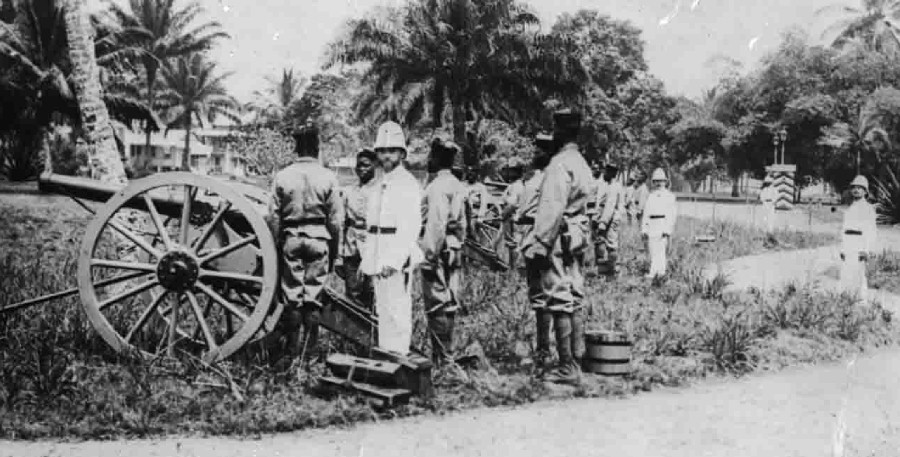
The Cameroon
Artillery Detachment at Duala Exercising with their 8.8cm Feldkanone C73/91
Photo by Major Langheld
©
Frankfurt University Koloniales Bildarchiv |
|
| |
|
|
|
|
| |
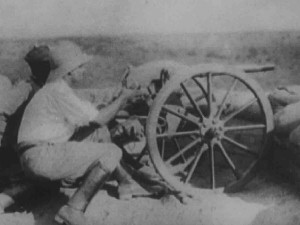
3.7cm Krupp-Gruson Schnell-Ladekanone M93
Operated by a German officer and African soldier of
the Cameroon Schutztruppe.
Photo
©
Frankfurt University Koloniales Bildarchiv |
|
By 1914 the Cameroon Schutztruppe had formed one artillery
Abteilung in the capital Duala consisting of four field guns and had
a few other guns distributed among the Feldkompagnien.
During the First World War they were hampered by a shortage of
ammunition.
4
x 8.8cm Schwere Feldkanone C73/91
These four Heavy Field Guns
were formed into a single Artillery Abteilung based at Duala.
3
x
3.7cm Krupp-Gruson Schnellladekanone L/30 M1893
These Quick Firing Guns were distributed among the Schutztruppe Feldkompagnien.
The 6, 10 and 11.FK had one each.
3 x 6cm Gebirgshaubitze
These three mountain howitzers were distributed among the Schutztruppe Feldkompagnien.
The 7.FK had two while the 8.FK had one.
|
|
| |
|
|
|
|
| |
|
|
|
|
| |
|
|
|
|
| |
Togo
There was no German artillery in Togo.
|
|
| |
|
|
|
|
| |
|
|
|
|
| |
|
|
|
|
| |
New Guinea
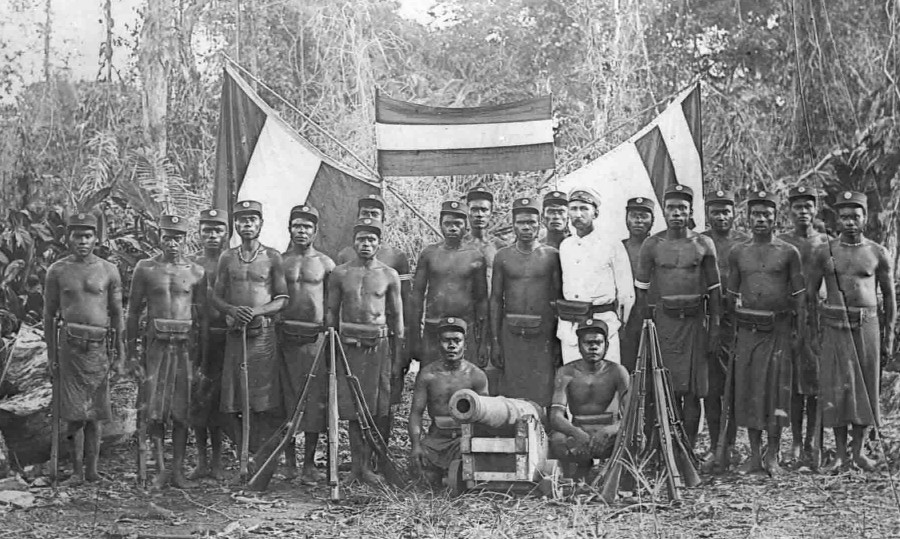
New Guinea Company Polizeitruppe 1899 with an antiquated Muzzle Loading Naval Gun
Photo ©
Frankfurt University Koloniales Bildarchiv |
|
| |
|
|
|
|
| |
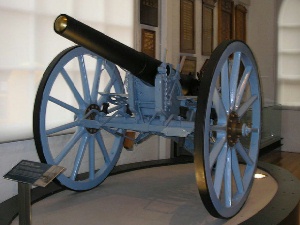
C73 Field Gun
Captured At Rabaul 1914
Displayed at the Royal Australian Navy
Heritage Centre in Sydney.
Photo by Nick Dowling /
WikiCommons |
|
The Polizeitruppe of German New
Guinea did not have a regular artillery contingent.
One photograph of
the New Guinea Company Polizeitruppe in
Friedrich-Wilhelmshafen taken in 1899 shows
them posing with a very old small naval muzzle loading gun. Its
effectiveness in modern warfare would have negligible though it
may have been useful in impressing local tribesmen.
At the outbreak of war in 1914, the
islands of German New Guinea had the following guns, none of
which were used in combat.
2x
3.7cm Gruson-Hotchkiss
Revolverkanone L/30 M1893
In July 1914 the survey ship SMS Planet landed two revolver
canons in New Guinea. One at
Friedrich-Wilhelmshafen
and the other at Jap to protect the radio station.
(Source "Die Polizeitruppe Deutsch-Neuguineas 1887-1914" by Thomas Morlang
at
Traditionsverband)
2x
7.85cm Leichte Feldkanone
C73
There were two 7.85 cm
C73 Krupp light Field Guns at Rabaul
for saluting purposes. They
did not take part in the defence of New Guinea in 1914
presumably because of a lack of ammunition.
Recommended Internal Link-
Rabaul Guns |
|
| |
|
|
|
|
| |
|
|
|
|
| |
|
|
|
|
| |
Samoa
German Samoa had one
out-dated artillery piece that took half an hour to load and was
ceremonially fired once a day from Apia harbour. As far as is
known, it was never fired in action. The source of this gun, its
current whereabouts and any more details about it are not known. |
|
| |
|
|
|
|
| |
|
|
|
|
| |
|
|
|
|
| |
|
|
|
|
| |
China
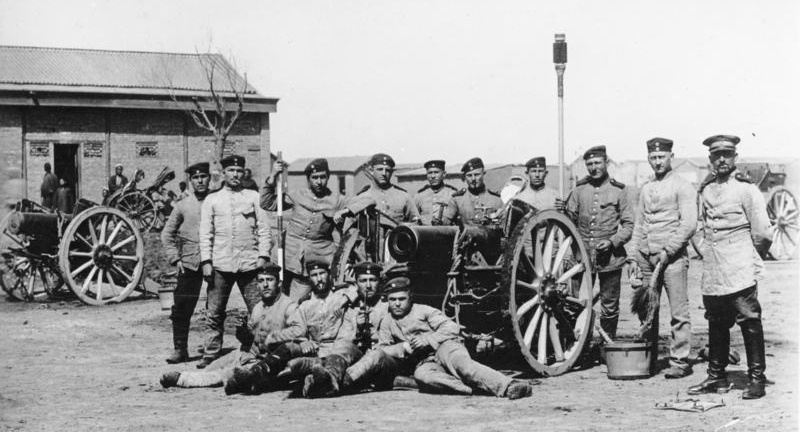
10.5 cm Feldhaubitze M98
of the
4th or 5th East Asian Field Howitzer Battery,
Peking 1900
Photo from Bundesarchiv /
WikiCommons
Artillery of the East Asian
Expeditionary Corps
The artillery regiment of the East Asian
Expeditionary Corps was formed at Jüterborg sailed for China in 1900
to fight in the Boxer Rebellion. The size of the artillery
contingent in China was gradually reduced over the following years.
In 1900 the East Asian Artillery Regiment
consisted of nine batteries organised as-
1st-3rd Field Artillery Batteries
4th-5th Light Field Howitzer Batteries
6th Field Artillery Battery
7th-8th Mountain Gun Batteries
Naval Field Artillery Battery of the Marine Expeditionskorps
There was also a battalion of heavy
artillery organised as-
1st-2nd Heavy Field Howitzer Batteries
By June 1901 the artillery of the East
Asian Occupation Brigade was reduced to three batteries-
1st Field Artillery Battery
2nd Light Field Howitzer Battery
3rd Mountain Artillery Battery
The following year, in
June 1902 they had been further reduced to-
1st Field Artillery Battery
2nd Mountain Artillery Battery
The mountain artillery battery was
disbanded later that year leaving the single field artillery battery.
The East Asian occupation forces were was disbanded in 1909.
I have so far found no source confirming
exactly which guns were used by which units but from the few period
photographs I have seen, it would appear that the field artillery
batteries were equipped with the
7.7cm Feldkanone C96aA, the
mountain artillery batteries had the
7.2 cm Gebirgskanone L/14 M98,
light field howitzer batteries were armed with the
10.5 cm Feldhaubitze M98
and the heavy field howitzer batteries had the
15 cm schweres Feldhaubitze M93.
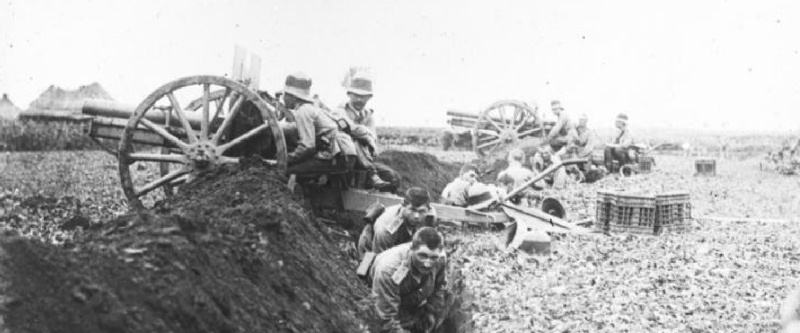
Marine Feldbatterie with a pair
of FK96nA guns on a training exercise near Tsingtao c1914
Photo from Bundesarchiv /
WikiCommons
Marine Field Battery at Tsingtao
The III. Seebataillon
based at Tsingtao had a field artillery battery armed with the
Feldkanone
C96nA to support their
actions. This battery was put into action during the Siege of
Tsingtao in 1914.
The East Asian Marine
Detachment also had two or three FK96nA guns in Peking and
Tientsin.

21cm Gun
from either the Bismarckberg or Hsia Un Iua Batteries, Captured by the Japanese
at Tsingtao, November 1914
Photo from
Bundesarchiv /
WikiCommons
Naval Batteries at
Tsingtao
The home base of Germany's East Asian Fleet had been
gradually fortified over the years since its
occupation in 1897. By the time the Japanese laid
siege to Tsingtao in 1914 it had large numbers of
land based naval guns, many of which were housed in
reinforced concrete cupolas. The Japanese also had
to contend with the supporting gunfire of the
remainder of the East Asian Fleet, some of which was
later transferred onto land and the field artillery
of the III. Seebataillon and the East Asian Marine
Detachment.
|
Land Front Batteries ("Landfrontbatterien")
under the command of Kapitänleutnant Wittman |
| 2 x 10.5cm guns |
Batterie "Ober Iltisberg" |
| 6 x 12cm guns |
Batterie "Unter Iltisberg" |
| 2 x 21cm guns |
Batterie "Bismarckberg" |
| 2 x 12cm guns |
Batterie "Taitung Cheng" |
| 6 x 9cm guns |
Independent batteries |
| 3 x 3.7cm guns |
Independent batteries |
| |
|
|
Sea Front Batteries ("Seefrontbatterien")
under the command of Fregattenkapitän Huss |
| 2 x 24cm and 3 x 15cm guns |
Batterie "Hui Chuen Huk" |
| 4 x 15cm guns |
Batterie "Tsingtao" |
| 4 x 21cm guns |
Batterie "Hsia Un Iua" |
| 4 x 28cm howitzers |
Batterie "Bismarckberg" |
| 4 x 8.8cm guns |
Batterie "Yunnui San" |
| 2 x 8.8cm guns |
Batterie "Mohlenkopf" |
These guns delayed the
Japanese Siege of Tsingtao and forced them to invade
through neutral Chinese territory rather than face a
frontal assault. The
guns from the SMS Jaguar and the
Austro-Hungarian SMS Kaiserin Elisabeth were also added
to the land batteries during the Siege of Tsingtao in
1914. After two
months of siege the batteries ran short of ammunition
and this ultimately forced the German surrender.
Recommended External Links -
Discussion on the Tsingtao Naval Artillery at the
Feldgrau
Forum and the
Heroes of Tsingtao mention of landed artillery from ships at
the Siege of Tsingtao at
Jaduland.
|
|
| |
|
|
|
|
| |
|
|
|
|
| |
|
|
|
|
| |
Sources and Links
Published
Sources
"Die Kaiserliche Schutz-
und Polizeitruppe für Afrika" by Reinhard Schneider
(Published by Druffel & Vorwinkel-Verlag)
"The German Colonial Troops
1889-1918" by
Jürgen Kraus and Thomas Müller
(Published by Militaria Verlag)
"Die Deutsche Schutztruppe
1889/1918" by Werner Haupt
(Published by Dörfler)
"Lettow-Vorbeck's Soldiers"
by Walther Dobbertin
(Published by Battery Press)
"Armies in East Africa 1914-18"
by Peter Abbott, illustrated by Raffaele Ruggeri (Published by Osprey Men at Arms)
Recommended External Links
Lovett Artillery
German East African Artillery discussed in Depth on the
Panzer
Forum
More discussions on the
Panzer Forum,
Panzer Forum and
Panzer Forum
Discussions on the
Axis History Forum,
Axis History Forum and
Axis History Forum
German guns of World War One in South Africa"
by Major Darrell D. Hall, 1974 at
South African MilitaryHistory
Wanganui Library Krupp C73 Article
"Die Polizeitruppe Deutsch-Neuguineas 1887-1914" by Thomas Morlang
at
Traditionsverband
Discussion on the Tsingtao Naval Artillery at the
Feldgrau
Forum and the
Heroes of Tsingtao mention of landed artillery from ships at
the Siege of Tsingtao at
Jaduland.
Recommended Internal Links
SMS Königsberg Guns
Schutztruppe Mountain Guns
Schutztruppe
Artillery Recovered from Lake
Otjikoto
East African
Polizeitruppe Artillery
East African Ersatz Field Gun
Rabaul Guns
Decoy Guns
Many people such as MC Heunis, Bob
Wagner, Dominic Hoole, Bruce Swanton, Phil Buhler, Vincent Wratten, Arne Schöfert,
Per Finstead,
Aaron Carson and the
the very helpful members of the
Axis History Forum assisted and advised me with this article but the research already
done and shared by Holger Kotthaus, Oliver Eicke, Mark E Horan
and Charles Rollins Ware on various forums linked above was
invaluable. Thanks is due to all these people men.
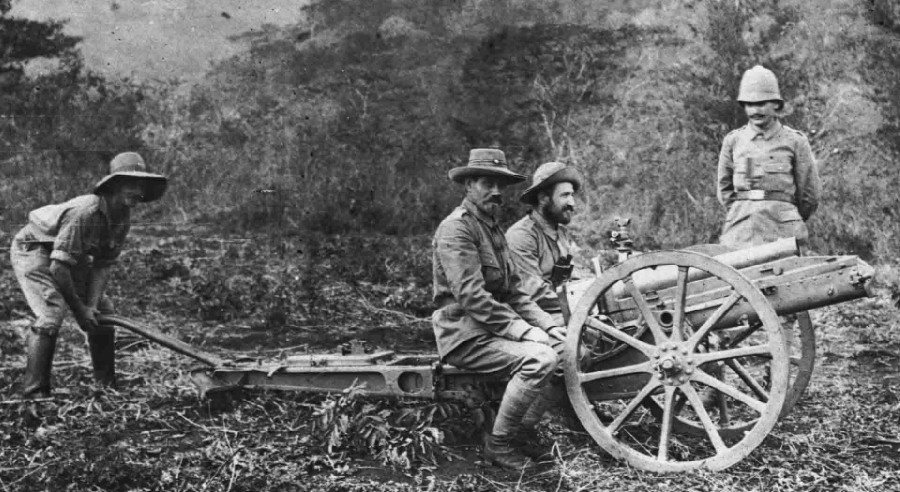
7.5cm Gebirgskanone
M08 from the SS Marie in German East Africa
Note the recoil system below the barrel and the gunner on the left
using a lever to adjust the traverse of
the gun by moving the gun carriage.
Photo ©
Frankfurt University Koloniales Bildarchiv
|
|
| |
|
|
|
|
| |
|
|
|
|
| |
|
|
|
|
| |
Please
contact me here if you have more
information or photos on this topic
Back to
Main Menu for German Colonial Uniforms |
|
| |
|
|
|
|
|